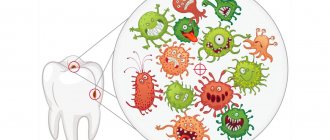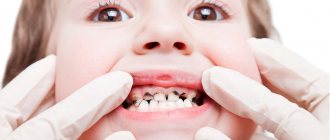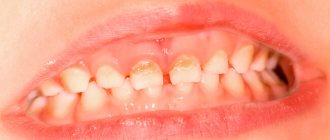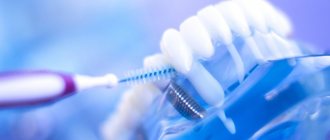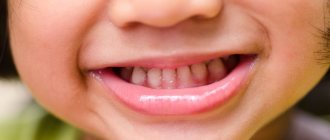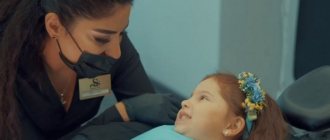Treatment of caries of children's primary teeth
Caries of primary chewing and front teeth has long been treated without the slightest pain.
New modern techniques have reduced the use of drills and drilling to a minimum, and timely scheduled examinations make it possible to detect the disease at a very early stage. The doctors at Aza&Buka Pediatric Dentistry who work with young patients are distinguished by an amazing sense of tact and constant positivity. Knowledge of the child’s psychology allows doctors to build communication and dialogue in such a way that children sit in the dental chair without the slightest fear. If the child already has some dental phobia, then adaptation techniques can solve the problem.
Caries on baby teeth in children is treated using the following technologies:
Pediatric anesthesia in dentistry
First, let's figure out what anesthesia is. This is a reversible inhibition of the activity of the central nervous system, which we cause artificially.
Narcosis is characterized by:
- falling asleep and decreased reflexes;
- loss of consciousness and muscle relaxation;
- complete absence of painful sensations.
Translated into simple language, this means that during general anesthesia the child falls deeply asleep, lies motionless during the procedure and does not feel anything. And after waking up he doesn’t remember anything.
They are immersed in this state using a combination of several drugs, which ensures safety and comfort for the baby. At the same time, safety comes first. Modern methods of general anesthesia completely eliminate the negative impact on the mental and physical development of a small patient.
Unlike adult dentistry, in pediatric dentistry there is no intermediate option between superficial sedation and anesthesia. This means that for children under 16 years of age there are only two options for “sleep treatment”: superficial sedation, when the child remains awake during treatment, and general anesthesia (endotracheal anesthesia). This is due to the anatomical and physiological characteristics of children. Because of them, deep intravenous sedation is impossible.
Classic filling
requires a special approach when treating young patients, since the doctor has to use dental equipment, which often causes fear in children.
Aza&Buka dentistry uses both traditional and modern methods of treating caries of primary teeth, selecting a method taking into account the age of the child and the degree of neglect of the process.
Plaksina Margarita
“Modern parents are great! They themselves are not afraid of dentists, and children are taught the same thing: to come on time for preventive appointments and examinations. In such cases, doctors can intercept the very beginning of a cavity infection and prevent tooth decay without drilling.”
Preparation for the procedure
Before dental treatment for children, it is important for parents to prepare thoroughly. Preliminary activities include choosing a suitable clinic and specialist, psychological preparation of the child for the upcoming procedure. When choosing a medical institution, parents should pay attention to the level of its equipment and the availability of specialists working directly with children.
Choosing a clinic
A child’s first meeting with a dentist should go well so that he or she does not develop dental phobia in the future. Only a pediatric dentist who has the necessary skills and can find a common language with the patient should treat children’s teeth. Before choosing a medical institution, it is advisable to read reviews on the Internet. Nowadays, it is not difficult to find comments from other people regarding a clinic or a particular attending physician.
No less important is the child’s personal impression. The main task of a pediatric dentist is to dispel the patient’s fear, and not to frighten him with his severity. You should also find out in advance about the equipment of the clinic and what services are offered there. In dentistry, painless dental treatment methods have been practiced for the last few years. Some clinics offer anesthesia for the treatment of deep caries, which will minimize the discomfort from the doctor’s manipulations.
Premedication - psychological preparation
In order to relieve pain symptoms, the child is allowed to give painkillers. It is advisable to carry out premedication (preliminary drug preparation to reduce anxiety in a small patient) immediately before showing the child to the dentist. The procedure is aimed at combating pain in several directions:
- Touch. To eliminate the sensitivity of the problem area, drugs such as Lidocaine, Novocaine or Benzocaine are used.
- Psycho-emotional. You can prepare your child for a trip to the dentist through conversations and persuasion or through medication. Sedatives will help reduce the severity of anxiety symptoms: Persen, Ten-a-ten. Medicines with a sedative effect are especially necessary for patients suffering from epilepsy, diabetes, and thyroid pathologies.
In addition to painkillers and sedatives, patients are also prescribed drugs with a sedative effect (Zodak, Zyrtec), which prevent possible allergic reactions during treatment. Preference is given to 4th generation drugs, since they do not cause drowsiness and dryness of the mucous membranes of the mouth
Milk caries: initial, superficial, medium, deep
Doctors distinguish 4 stages of the formation of carious areas:
- Initial caries - tooth enamel becomes covered with small spots of white or yellowish tint.
- Superficial caries - the enamel begins to deteriorate, small and light cavities are observed.
- Medium – the layer of tooth enamel is destroyed, the affected area extends deeper.
- Deep - the layers of dentin have already been affected, and the pulp is under threat.
It is necessary to treat milk caries at the very first stage, although it does not cause any discomfort in the child. The fact is that the enamel and crowns of temporary teeth are subject to rapid destruction, and the development of caries occurs very quickly. Deep caries often provokes irreversible changes, which leads to premature removal of the baby tooth.
Rodikova Tatyana
“Medium and deep caries most often occurs in schoolchildren, almost teenagers. Children brush their teeth poorly, and they talk about problems only when caries has already affected the pulp. In this case, the treatment turns out to be more unpleasant, since removal of the pulp cannot be avoided. That’s why I always ask parents to carefully monitor their teenagers’ hygiene and bring them to appointments on time.”
Anesthesia for dental treatment
Treating a child’s tooth while sleeping is much more convenient and safer. Therefore, often in children, dental treatment under anesthesia is preferable to without it. At the same time, dentists are confident that the use of gas as anesthesia does not cause any harm to the body, even of an infant.
Treating teeth under anesthesia for a child aged 2 to 4 years is one of the most convenient and popular methods. The inhalation method is based on the fact that the baby simply inhales a special mixture, and then calmly falls asleep. Doctors provide treatment, and then the child wakes up with no memory or pain or fear of doctors.
To use inhalation anesthesia, the clinic must have a license, the necessary equipment, and an experienced anesthesiologist who knows how to work with children. It is important to remember that under general anesthesia, teeth are treated only for a healthy child - he should not have a cold, and at least two weeks must have passed since the acute respiratory infection, acute respiratory viral infection or other illness. Also, do not use this method immediately after vaccination.
Local anesthesia is another popular method of pain relief. But if it is customary to treat teeth in a dream in young children, then this method can be used in schoolchildren. Its essence is that an anesthetic drug is injected into the gum using a syringe and a needle, which will not allow the child to feel pain during treatment.
All modern technologies that exist in Russia only work to quickly cure teeth at the moment when they manage to persuade the child to open his mouth. But can the quality of such treatment be at its best? It will not be possible to completely remove infected and diseased tissue. Not to mention fillings, whose task is to harden faster in order to somehow cover carious holes. This leads to the fact that soon the parents bring the child to the doctor again, but now with even greater problems.
An equally popular problem is the baby’s fear. Therefore, inhalation anesthesia is an easy way to cure a child’s carious teeth in one visit to the doctor, and then not remember about this procedure until the next preventive examination.
Reasons for the development of caries in temporary teeth
When visiting a dentist, parents are invariably interested in the reasons for the appearance of such an unpleasant disease. This is important because it helps prevent damage to new teeth. Sometimes it is enough to change eating habits and hygiene patterns so that the child forgets about fillings for a long time, and only comes to the dentist for examinations.
Causes of caries:
- Poor or insufficient oral hygiene. Food remains in the interdental space and on the enamel are an excellent environment for the development of carious bacteria.
- An unbalanced diet with a preponderance of sweets and carbohydrates - during the fermentation of simple carbohydrates, acids are formed that provoke the destruction of enamel.
- The lack of solid foods in the menu leads to a decrease in the frequency of chewing, reduces salivation and becomes a common cause of caries of primary teeth in young children.
- Long-term use of nipples, including on bottles and sippy cups, increases the risk of developing single or multiple bottle caries of the anterior milk teeth in children.
- Rickets is a pathology that provokes the destruction of dental tissues.
- Genetic predisposition of the child.
- Problems with bite – various anomalies in the formation of the dentition.
- Decreased natural immunity due to frequent acute respiratory viral infections, chronic diseases, and taking various medications.
- Damage to tooth germs in the prenatal period - due to maternal illness or neglect of health in the first trimester.
How to prepare a child for dental treatment under anesthesia
- Before treatment, you should consult with an anesthesiologist. This can usually be done over the phone, but in some cases a face-to-face appointment is required.
To correctly administer general anesthesia, the anesthesiologist will need the following information:
- child development history;
- allergic reactions;
- past acute and chronic diseases;
- previous medical interventions and hospitalizations;
- anthropometric data (age, height, weight).
To clarify the child’s health status, you will need to undergo a series of tests. The anesthesiologist determines the full scope of the required examination based on the characteristics of the small patient and the type of upcoming treatment.
- Before anesthesia, diet is very important. The safety of anesthesia depends on its compliance.
The child who will best tolerate anesthesia is the one who:
- did not eat “heavy food” during the 6 hours preceding treatment;
- 4 hours before the procedure I had a snack;
- I drank water 2 hours before.
Dietary recommendations may vary, so the final meal plan will be discussed in consultation with the anesthesiologist.
- To help parents not be nervous, I also recommend asking the anesthesiologist what his qualifications are and what equipment he will use during the procedure. You definitely shouldn’t be embarrassed about such questions. Doctors with experience in pediatric anesthesiology should work with children, since the structure of the child’s body and its functioning have their own characteristics.
How is dental treatment performed for children under anesthesia?
During treatment under general anesthesia, the child does not feel anything. And he doesn’t remember anything after waking up. This is achieved by a combination of drugs. The main one among them is Sevoran.
The combination of drugs and their doses are calculated individually for each child. In this case, the doctor takes into account the age, weight and characteristics of the small patient. The use of combinations of anesthetics makes it possible to minimize their doses and carry out a high-quality and safe procedure.
The child falls asleep after a few breaths through the mask of the anesthesia machine. This happens in the arms of the mother. We perform induction of anesthesia as comfortably as possible for the baby. If a child comes with his favorite toy, we show her by example: inhalation from a mask is not scary.
In cases where parents warn the anesthesiologist that even a mask causes negative emotions in the child, premedication can be used. Then we administer a mild sleeping pill to the baby in the form of nasal drops, after which the child plays or watches cartoons for 30-40 minutes and gradually falls asleep in his mother’s arms. And then we begin induction of anesthesia.
An anesthesiologist and a nurse anesthetist are responsible for administering general anesthesia. Their interaction ensures the safety of the child. The baby is under constant control, precisely calculated doses of drugs are administered at the appropriate time. It takes approximately 30 minutes in addition to the treatment time for the anesthesiologist to induce anesthesia and wake up.
Treatment methods in different clinics
In free public dental clinics, treatment methods differ from what private clinics offer patients. So, in case of superficial caries, it is disinfected and “silvered” with a special silver solution. If the case is more serious, then a standard filling is placed, and in advanced cases the tooth is completely removed.
There are also specialized dental offices for children, where treatment is carried out under anesthesia and sedation. Before starting these procedures, you need to consult a doctor and undergo an examination by the doctor who will treat the child in the future. Parents also need to make sure that the clinic they choose has passed state control and has all the documents to provide treatment.
In private structures, children's caries are treated in the same way as in adults, but the material for fillings is chosen to match the color of the teeth. They are removed during pulpitis , but some modern clinics offer canal filling using specialized methods, thanks to which the tooth will develop and last until natural replacement.
In case of severe destruction, a special crown or removable denture is placed on the tooth in one visit. In some cases, when a tooth is removed, a retainer is placed in its place, thanks to which the neighboring ones are not allowed to move, and the place for the future permanent one is preserved.
Parents from an early age are required to teach their children proper oral hygiene and brushing their teeth. If you teach them this, you can avoid frequent visits to the dentist with your child.
When should caries be treated?
There are a number of factors that indicate the need for treatment of caries in children, among them the following:
- the presence of an infection that provokes chronic exacerbation of various diseases;
- If caries is not treated at the first stage, the child may lose a tooth, and this can cause problems with chewing. The gastrointestinal tract becomes more vulnerable;
- If baby teeth are in poor condition, then the rudiments of permanent teeth may die.
Parents should be aware that every effort should be made to ensure that all affected primary teeth are saved.
Is sedation with ZAX safe?
Yes, it's safe. ZAX is completely harmless for children. Moreover, today it can be called the safest sedative. It is easy to use, is eliminated from the body without a trace, does not have a heavy or overly strong effect, and is not addictive. The child remains conscious, his breathing is not difficult, all reflexes are preserved. The use of ZACS ensures maximum safety, complete controllability and early activation of the patient.
You may have doubts about how well this technology has been tested. Despite the fact that it represents an innovation for Russia, ZAX sedation has long been used throughout the world (more than 30 years). The vast majority of pediatric dental clinics in the USA, Israel and the UK use ZAX as the main sedative. Thus, this technology can only be called new conditionally - it has long been tested and approved by professionals.

